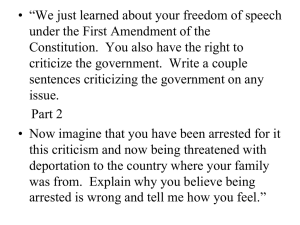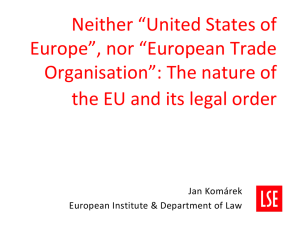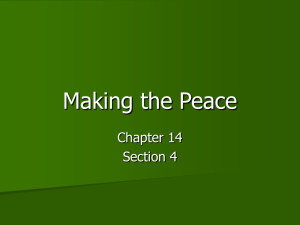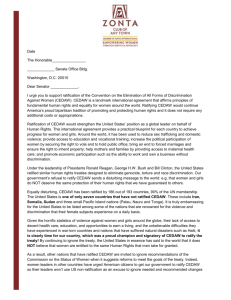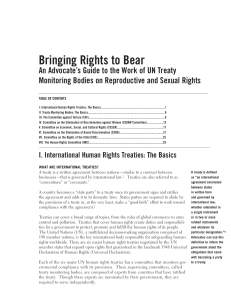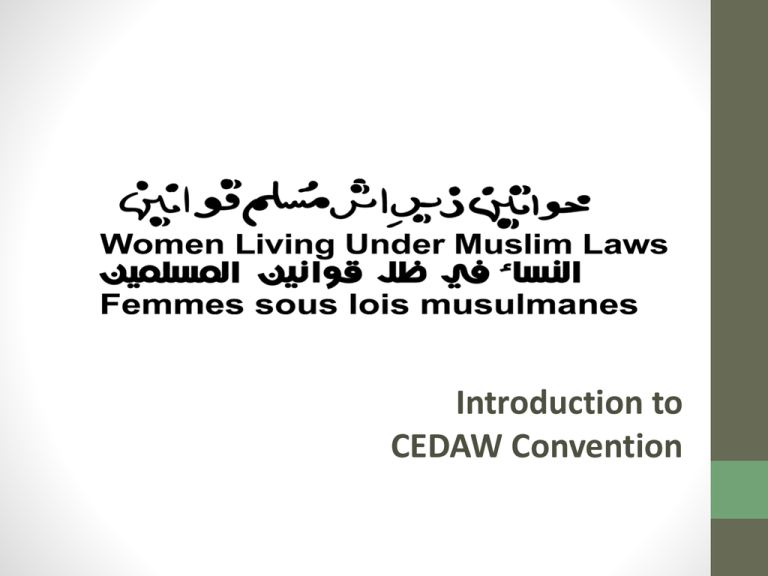
Introduction to
CEDAW Convention
I. Treaty body system
II. CEDAW session
1. Basic principles
2. Specific undertakings
3. Reporting process
Treaty body system
What is a treaty:
A ‘treaty’, ‘convention’ or a ‘covenant’ is an international legal
instrument. A treaty imposes binding legal obligations upon a
State who is a party to that treaty.
A State can become party to a treaty by ratifying it, which
means that the State voluntarily decides to be bound by the
provisions of the relevant treaty.
When a State becomes party to a treaty, it is obligated under
international law to uphold and implement the provisions of
the relevant treaty.
Treaty Body system
Who are parties to Treaties?
ONLY States:
States enter into treaties, and therefore accept obligations under
the treaties
Citizens, individuals, NGOs are NOT parties
They do not have a formal role in the treaty system unless invited
to participate by States
For implementation purposes, “States” means all constituent units
of the state (executive, legislative, judicial)
Treaties can also hold private actors accountable through States
Treaty body system
Treaty Bodies and the reporting process:
The treaty bodies were created in order to monitor and
encourage States to uphold and implement their international
obligations under the above-mentioned international human
rights treaties.
The treaty bodies are international committees of independent
experts who monitor State parties’ implementation of each of the
eight core human rights treaties and their optional protocols.
The implementation of each of the international treaties is
monitored by its own committee based on reports from State
parties and information from non-governmental organisations
(NGOs) and other relevant sources.
Convention on the Elimination of All Forms of
Discrimination against Women (CEDAW)
• Came into force in 1981
• First international treaty to systematically and substantively
address the needs of women
• States are responsible for a range of steps toward the practical
realisation of rights:
• individual violations and weaknesses in the systems and
institutions
• address stereotypes and discriminatory social and cultural
norms
• private and public spheres
• Strong international mandate – 184 ratifications
• Sets the stage for national level work
Structure of the Convention
Articles 1-5: General Substantive
Framework of the Convention
Articles 6-16:
Specific Substantive Areas -
Articles 17-23:
Committee and Procedures
Articles 23-30:
Administration, Interpretation
CEDAW’s Basic Principles
• Substantive Equality
• Non-discrimination
• State Obligation
Equality
1. Formal equality
- Does not recognize difference; treats men and women as the same
- Uses male standard, and puts burden on women to measure male standard
2. Protectionist equality
- Recognizes difference; considers women’s weakness as the rationale for
different treatment
- Women lose opportunities to obtain a varied range of opportunities due to
exclusion
3. Substantive equality
-
Recognizes difference and affirms equality between men and women
Places an obligation to correct the environment that disadvantages women
Equality of Opportunity; Equality of Access; Equality of results
Non-Discrimination
• Article 1
For the purpose of the present Convention, the term “discrimination
against women” shall mean any distinction, exclusion or restriction
made on the basis of sex which has the effect or purpose of
impairing or nullifying the recognition, enjoyment or exercise by
women, irrespective of their marital status on a basis of equality of
men and women, of human rights and fundamental freedoms in the
political, economic, social, cultural, civil or any other field.
State Obligation
• The framework to hold States accountable:
• Legally binding obligations
• Internal law is not an excuse for non-compliance
• State Party comprises ALL constituent units
• By ratifying a treaty, a State offers itself for scrutiny
on the basis of standards set forth in the Convention
• Articles 2-5 of CEDAW: General Undertakings;
Articles 6-16 of CEDAW: Specific Undertakings
General Substantive Framework
• Art. 1: Definition of Discrimination
• Art. 2: Measures to be Taken to Eliminate Discrimination
• Art. 3: Guarantees full development and advancement of
women
• Art. 4 Special Measures
• Art. 5 Modifying Social and Cultural Patterns of Conduct
Specific Undertakings
CEDAW, article 16
1. States Parties shall take all appropriate measures to eliminate discrimination against women
in all matters relating to marriage and family relations and in particular shall ensure, on a basis
of equality of men and women:
• (a) The same right to enter into marriage;
• (b) The same right freely to choose a spouse and to enter into marriage only with their free
and full consent;
• (c) The same rights and responsibilities during marriage and at its dissolution;
• (d) The same rights and responsibilities as parents, irrespective of their marital status, in
matters relating to their children; in all cases the interests of the children shall be
paramount;
• (e) The same rights to decide freely and responsibly on the number and spacing of their
children and to have access to the information, education and means to enable them to
exercise these rights;
• (f) The same rights and responsibilities with regard to guardianship, wardship, trusteeship
and adoption of children, or similar institutions where these concepts exist in national
legislation; in all cases the interests of the children shall be paramount;
• (g) The same personal rights as husband and wife, including the right to choose a family
name, a profession and an occupation;
• (h) The same rights for both spouses in respect of the ownership, acquisition management,
administration, enjoyment and disposition of property, whether free of charge or for a
valuable consideration.
2. The betrothal and the marriage of a child shall have no legal effect, and all necessary action,
including legislation, shall be taken to specify a minimum age for marriage and to make the
registration of marriages in an official registry compulsory.
Steps of the reporting process
(1) Ratification of Convention
(2) Submission of Government report
One year after ratification; every four years thereafter
Get assigned a session; country rapporteur
Civil society opportunity to prepare shadow/alternative report
(3) Pre-session working groups
Creation of list of issues and questions
Civil society opportunity to submit (suggested) list of issues and questions
(4) Response to list of issues and questions
Steps (cont’d)
6)
Constructive dialogue
Two three hour sessions; divided by cluster of articles
Civil society/NHRIs opportunity present oral statement
NGO oral statement….
7)
Concluding observations
8)
Follow up procedure
-
criteria : ‘the fact that their lack of implementation would constitute a major obstacle for
the implementation of the Convention as a whole and that they should be achievable
within the set timeframe of one or two years.’
* Exceptional Reports





